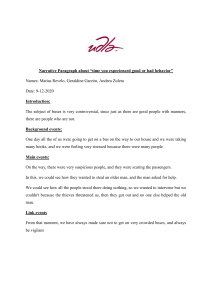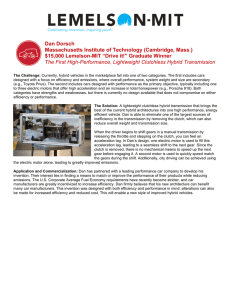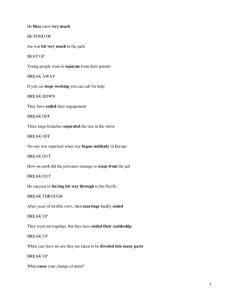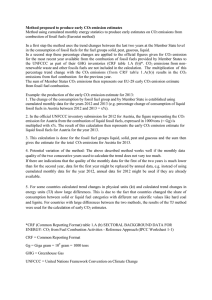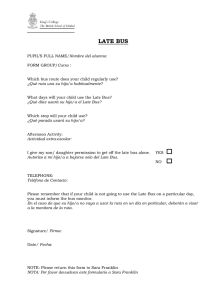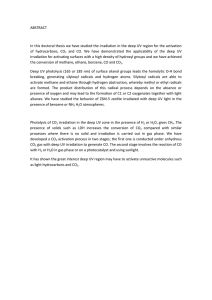London Buses Emissions Reduction
Anuncio
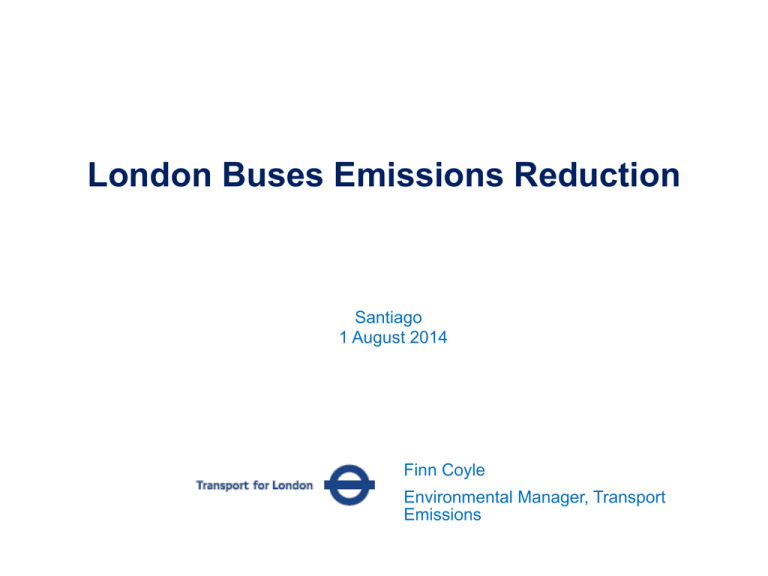
London Buses Emissions Reduction Santiago 1 August 2014 Finn Coyle Environmental Manager, Transport Emissions Agenda • The London bus network and its environmental impact • Environmental Challenges • Understanding the Impact • Hybrid and ‘Zero Tailpipe Emission’ buses 2 Network contracted by TfL from Private Operators Buses operate 24 hours per day, 7 days a week The London Bus Network 19,500 bus stops 6.5 million journeys per week day 8,500 buses 700 routes 3 The London bus system: organisation The Mayor Strategy Chair of TfL Board Fares Transport for London Service planning & contracting. Monitoring of output and quality. Consultation & engagement. Vehicle Specifications. Stops, stands, stations. Information. Research & advice. Private sector contractors Tender for services. Run services to TfL standards. Employ drivers, controllers, engineers and other operating staff. Own assets, including buses and garages. Bus usage in London 1963-2014 5 Environmental Challenges • EU Limit Values of 40 µg/m3 for NO2 and PM • PM just below limit (though no safe level) • NO2 is 3 times higher than limit value in some areas • Mayor has targeted 60% reduction in CO2 by 2025 from 1990 levels 6 Calculating the Environmental Impact of the Bus Fleet • TfL developed with Millbrook a ‘real world’ drive cycle based on Route 159 from Brixton to Oxford Street • Every new type of bus is tested to ensure CO2, PM and NOx emissions meet TfL’s requirements • Enables TfL to model the impact of the Bus Fleet on London emissions and predict the impact of interventions such as hybrid buses 7 Fleet Emission Trends 1997-2013 700 7000 6000 600 5000 500 4000 400 3000 300 2000 200 1000 100 0 0 1997 2001 2002 2003 2004 2005 2006 2007 2008 2009 2010 2011 2012 2013 TfL Retrofitted Diesel Particulate Filters (DPF) on all its Euro II and III buses 8 NOx emissions p.a. PM10 and CO2 emissions p.a. 800 PM10 - Tonnes CO2 - Kilotonnes NOx - Tonnes Hybrid trial and evaluation § Hybrids chosen as the offered the most cost effective means of CO2 reduction § The hybrid programme has spurred bus manufacturers to develop hybrid buses § Trials consisted of 56 buses across 8 major operators § £5.4 m London Government Climate Change fund for the additional on-cost of the vehicles and 5 year warranty § Monitoring and evaluation period 2006 to 2010 § Four manufacturers – ADL, Volvo, Wrights and Optare – single and double deck § 30% CO2 saving to be demonstrated over MLTB test cycle – Low Carbon Bus Certificate Hybrid whole life cost – issues that affect contract price • Capital cost of vehicles • Life of batteries and replacement cost • Drive motor and other hybrid component life costs • Maintenance costs • Finance leasing and residual values • Fuel costs Hybrid Buses - Deployment All operators bid with prices for ‘diesel’ or ‘hybrid’ buses A competitive price for hybrid buses will have more change of winning the tender – hybrid buses will then be specified in the contract 800 hybrid buses now in service 1700 to be in service by 2016 £23m UK Government Green Bus fund part funded the on-cost of 334 Hybrid buses GBF1 – 80% funding GBF2 – 70% funding GBF3 – 60% funding GBF4 – 50% funding 11 New Routemaster New Routemaster with second generation hybrid technology demonstrates even more significant benefits 47% reduction in CO2 78% reduction in NOx Flywheel Technology The Williams hybrid system utilises a high speed flywheel that stores energy (from braking for example) and releases the energy to aid vehicle propulsion – significantly lower cost – 20-30% CO2 reduction – 25 single deck buses going into service this year with more planned – No zero emission capability 12 Electric, Plug-in Hybrid Bus & Induction Charging Trial • • • 2 Pure Electric Buses from BYD in service on route 507 and 521 6 more electric buses from Optare going into service this year 4 Inductively charged hybrid buses going into service in 2015 13 Hydrogen Fuel Cell Buses • Zero ‘tailpipe’ emission buses • A fleet of 8 hydrogen buses are in operation • Aim to achieve operation as close as possible to diesel buses • New maintenance and refuelling facility constructed within a standard bus depot • Longer term strategy 14 Emissions Projections 15 Environmental Targets 1700 hybrid buses by 2016 All buses to meet Euro IV standard for PM and NOx by 2015 to be met by retrofit of SCR and accelerating the uptake of Euro VI Ultra Low Emission Zone proposed for central London by 2020 All double deck buses operating in central London to be hybrid by 2020 All single deck to be ‘zero tailpipe emission’ (electric or hydrogen) by 2020 16 Summary and recomendations • Hybrids biggest contributor to CO2 reduction with increasing emphasis on further electrication • Electric and hydrogen buses offer potential to move to zero emissions policy in future • Essential to set a CO2 reduction target for hybrids – e.g 30% less CO2 over a real world drive cycle • Many of the hybrid drive-lines, control and battery management systems in use and proven in London could be integrated into buses used in Chile Questions?
